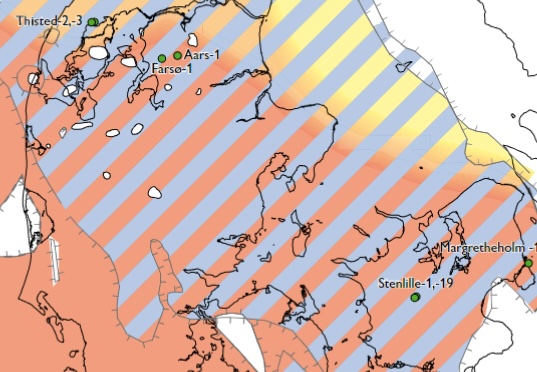
How to Cite
Share
Abstract
The Danish subsurface contains several sandstone units, which represent a large geothermal resource (Vosgerau et al. 2016). Currently, only three geothermal plants are operating in Denmark, but several exploration licences are expected to be awarded in 2019. Geothermal energy is exploited from deeply buried porous sandstones by bringing warm formation water (brine) to the surface, extracting the heat and returning the cooled water to the same sandstones. The reduced temperature of the brine during this process implies a risk of scaling, which may reduce reservoir permeability and hence injectivity. Predicting the chemical composition of formation waters, however, could help to reduce the risk associated with scaling in planned geothermal facilities.
Here, we present a regional overview of the geochemistry of brines from deep Mesozoic sandstones in the Danish Basin and North German Basin that supplements previous studies, notably by Laier (2002, 2008). The brine composition at shallow burial typically reflects the original (connate) formation water chemistry, which is determined by the original depositional environment of the sandstone, for example fluvial or marine. However, the mineralogical composition of the sandstone changes during burial, whereby some minerals may dissolve or precipitate when exposed to higher temperatures. These mineral changes are reflected in the brine composition, which typically becomes more saline with increased burial (e.g. Laier 2008; Kharaka & Hanor 2003).
The brine chemistry reported here shows a distinct depth trend, which reflects original connate formation waters that are modified through burial diagenesis. We have classified the brines into brine types, which are shown to be related to their depositional environment, depth, geological formation and geographical domains.
----------
There was an error published in GEUS Bulletin 43 (article 201943-01-04; DOI: 10.34194/GEUSB-201943-01-04). Tables 1 and 2 contained typesetting errors. The original and corrected data are listed below. All formats of this article have been updated (October 2022). The authors and editorial team apologise to readers for this error, which does not impact the overall results or conclusions of this paper.
Table 1: Ca:Cl original: 00.04; 00.08; 00.04; 00.16; 00.16; corrected: 0.04; 0.08; 0.04; 0.16; 0.16 ; pH original: 06.06; 06.03; 05.09; 06.03; corrected: 6.6; 6.3; 5.9; 6.3
Table 2: Anhydrite original: 00.35; corrected:0.35; Halite original: 00.39, 00.03; corrected:0.39, 0.03; Barite original: 00.40, 00.03; corrected: 0.40, 0.03; Celestite original: 00.08, 00.04; corrected: 0.08, 0.04
Versions:
- 17-10-2022 (2)
- 17-07-2019 (1)










